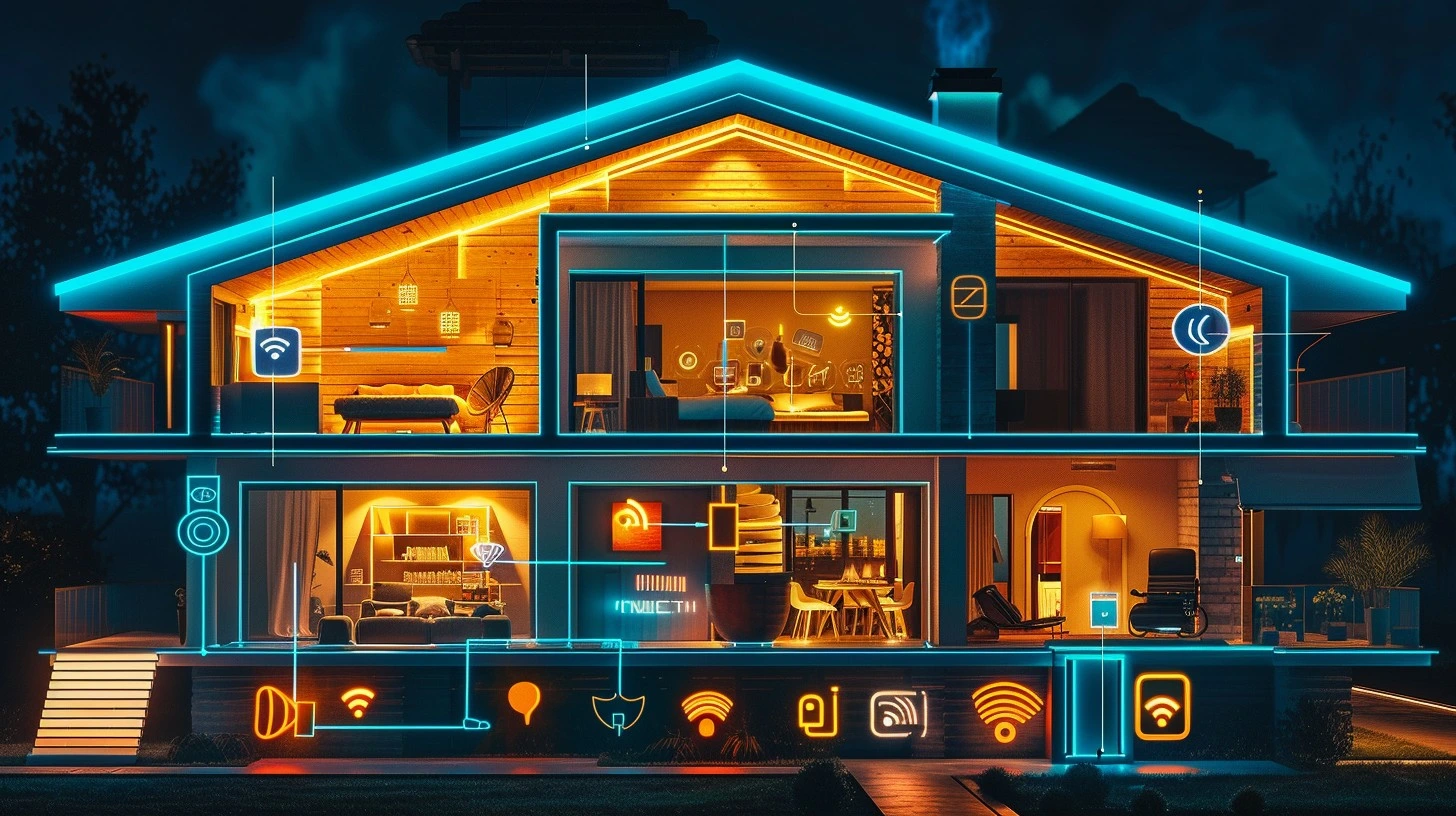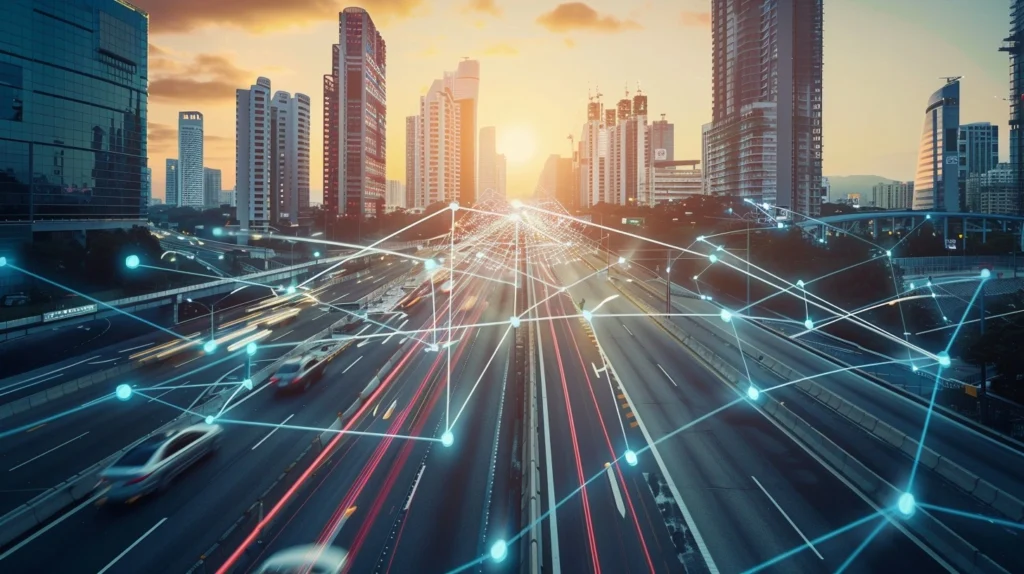
Introduction
The Internet of Things (IoT) is transforming the way we live, work, and interact with the world around us. With billions of devices now connected to the internet, The Internet of Things is paving the way for a fully connected world where everyday objects are able to communicate, exchange data, and provide new insights. This article explores the current state of The Internet of Things, its applications, and what the future holds as we move toward a more interconnected world.

What is IoT?
The Internet of Things is a transformative concept that has revolutionized how we interact with the world around us. It refers to the network of physical objects—devices, vehicles, appliances, and other “things”—that are embedded with sensors, software, and connectivity capabilities, allowing them to collect and exchange data over the internet. This interconnectedness enables these devices to communicate with each other and with central systems, creating a smarter, more efficient environment.
Key Components of IoT
- Devices and Sensors: At the heart of The Internet of Things are the devices and sensors that gather data from their environment. These can range from simple sensors that monitor temperature and humidity to complex devices like smart thermostats, wearables, and industrial machinery.
- Connectivity: The Internet of Things devices require a way to communicate with each other and with central servers. This can be achieved through various communication technologies, including Wi-Fi, Bluetooth, Zigbee, cellular networks, and more. The choice of connectivity depends on the specific application and the environment in which the devices operate.
- Data Processing: Once the data is collected, it needs to be processed and analyzed. This can occur on the device itself (edge computing), on a local server, or in the cloud. Data processing is crucial for extracting meaningful insights from the raw data collected by The Internet of Things devices.
- User Interface: To interact with the IoT system, users need an interface, which can be a smartphone app, web dashboard, or voice-activated assistant. This interface allows users to monitor, control, and receive notifications from their The Internet of Things devices.
How IoT Works
The Internet of Things operates through a continuous cycle of data collection, transmission, processing, and action. Here’s a simplified breakdown of the process:
- Data Collection: Sensors and devices collect data from their surroundings, such as temperature, motion, or light levels.
- Data Transmission: The collected data is sent over the internet to a central server or cloud-based platform.
- Data Processing: The data is analyzed and processed to generate insights. This can involve applying algorithms, machine learning, or data analytics techniques.
- Actionable Insights: Based on the analysis, the system can trigger actions. For example, a smart thermostat may adjust the temperature based on occupancy patterns, or an alarm system may notify homeowners of unusual activity.
Applications of IoT
The applications of The Internet of Things are diverse and span various industries, including:
- Smart Homes: The Internet of Things devices like smart thermostats, lighting systems, and security cameras enhance home automation and energy efficiency.
- Healthcare: Wearable devices monitor health metrics and enable remote patient monitoring, improving healthcare delivery.
- Industrial IoT : In manufacturing and logistics, The Internet of Things solutions optimize operations, reduce downtime, and enhance supply chain management.
- Agriculture: The Internet of Things applications in precision farming allow farmers to monitor soil conditions, crop health, and irrigation systems, leading to improved yields and resource management.
- Transportation: Connected vehicles and fleet management systems improve logistics and enhance safety on the roads.
Benefits of IoT
- Increased Efficiency: The Internet of Things enables automation and real-time monitoring, reducing the need for manual intervention and increasing operational efficiency.
- Enhanced Decision-Making: By providing access to real-time data, The Internet of Things helps businesses and individuals make informed decisions quickly.
- Cost Savings: The Internet of Things applications can lead to significant cost savings through optimized resource usage, reduced waste, and improved maintenance practices.
- Improved Quality of Life: In smart homes and cities, The Internet of Things technologies enhance convenience, safety, and sustainability, leading to a better quality of life.
Challenges of IoT
While the benefits of The Internet of Things are substantial, there are challenges to consider, including:
- Security Risks: The interconnected nature of The Internet of Things devices can make them vulnerable to cyberattacks and data breaches.
- Data Privacy: With the collection of vast amounts of personal data, concerns about privacy and data protection are paramount.
- Interoperability: Different The Internet of Things devices may use various standards and protocols, creating challenges in ensuring seamless communication and compatibility.
The Internet of Things is a rapidly evolving field that is reshaping industries and everyday life. By connecting devices and enabling data-driven decision-making, IoT has the potential to create a more efficient, sustainable, and connected world. As technology advances and challenges are addressed, the impact of The Internet of Things will continue to grow, driving innovation and improving the way we live and work.

Key Components of IoT
- Sensors and Devices
- The Internet of Things relies on sensors and devices that collect data from the environment. These sensors can measure temperature, light, motion, sound, and many other variables, transmitting this information to other systems or devices for processing.
- Connectivity
- Connectivity is essential to The Internet of Things, allowing devices to communicate with each other through networks like Wi-Fi, Bluetooth, or cellular. The rollout of 5G is expected to enhance IoT’s potential by providing faster and more reliable connections, even in remote areas.
- Data Processing
- Once data is collected, it is processed, either locally on the device or in the cloud. This processing helps convert raw data into meaningful insights, enabling better decision-making and automation.
- User Interface
- The user interface allows humans to interact with The Internet of Things devices and systems. This could be a mobile app, a web dashboard, or a voice command system like a smart speaker, providing easy access and control over connected devices.
Applications of IoT
The Internet of Things has emerged as a revolutionary technology, connecting devices, systems, and services to enhance efficiency, data collection, and user experience across various domains. The applications of IoT are vast and continually expanding, impacting industries and everyday life in profound ways. Here’s an exploration of some of the most significant applications of The Internet of Things.
1. Smart Homes
The Internet of Things technology has transformed ordinary homes into smart homes. Devices such as smart thermostats, lighting systems, and security cameras can be controlled remotely via smartphones or voice assistants. Homeowners can monitor energy usage, enhance security, and create personalized environments, all contributing to increased comfort and convenience. For example, smart thermostats learn user preferences and adjust heating or cooling settings automatically, optimizing energy consumption.
2. Healthcare
The Internet of Things is making significant strides in the healthcare sector. Wearable devices, such as fitness trackers and smartwatches, allow individuals to monitor their health metrics, including heart rate, sleep patterns, and activity levels. In clinical settings, The Internet of Things-enabled medical devices facilitate remote patient monitoring, enabling healthcare providers to track patients’ health in real-time. This capability not only enhances patient care but also reduces hospital visits and healthcare costs.
3. Industrial IoT (IIoT)
Industries are increasingly leveraging IoT technologies to improve operational efficiency and productivity. Industrial The Internet of Things involves connecting machinery, sensors, and systems to gather data and optimize processes. For instance, predictive maintenance can be implemented using The Internet of Things sensors that monitor equipment performance, allowing companies to address issues before they lead to costly downtime. IIoT applications also enhance supply chain management and logistics by providing real-time insights into inventory levels and shipment statuses.
4. Smart Agriculture
The Internet of Things is revolutionizing the agricultural sector by enabling precision farming practices. Farmers can use IoT sensors to monitor soil moisture, temperature, and crop health, allowing for data-driven decision-making. This technology helps optimize resource usage, such as water and fertilizers, leading to increased yields and sustainability. Drones equipped with IoT technology can also be employed for crop surveillance and mapping, providing farmers with valuable insights into their fields.
5. Transportation and Logistics
The Internet of Things applications in transportation and logistics are improving efficiency and safety. Fleet management systems utilize The Internet of Things devices to track vehicle locations, monitor driver behavior, and optimize routes. This data helps reduce fuel consumption, improve delivery times, and enhance overall operational efficiency. Additionally, The Internet of Things-enabled sensors in public transportation systems provide real-time updates on vehicle locations and schedules, improving the user experience for commuters.
6. Smart Cities
The concept of smart cities relies heavily on The Internet of Things technologies to enhance urban living. Cities are integrating IoT solutions for traffic management, waste management, and public safety. Smart traffic lights can adjust in real-time based on traffic flow, reducing congestion. The Internet of Things-enabled waste bins can notify waste management services when they need to be emptied, optimizing collection routes. Overall, smart city initiatives aim to create more sustainable and livable urban environments.
7. Retail and E-commerce
In the retail sector, The Internet of Things applications enhance customer experience and operational efficiency. Smart shelves equipped with weight sensors can monitor stock levels and automatically notify staff when items need restocking. Additionally, The Internet of Things devices can collect data on customer behavior and preferences, enabling personalized marketing strategies. In e-commerce, The Internet of Things can streamline inventory management and logistics, ensuring timely deliveries and improved customer satisfaction.
8. Energy Management
The Internet of Things technology plays a crucial role in energy management and sustainability. Smart grids utilize IoT sensors to monitor energy consumption and production in real-time, allowing for better distribution and reduced waste. Homeowners can install smart meters to track their energy usage, identify patterns, and make informed decisions about consumption. Additionally, renewable energy sources, such as solar panels, can be integrated with IoT systems for efficient energy management.
The applications of The Internet of Things are reshaping various sectors, enhancing efficiency, sustainability, and user experience. From smart homes and healthcare to industrial processes and smart cities, the impact of IoT is profound and transformative. As technology continues to evolve, the potential for IoT to further improve our lives and industries is boundless, paving the way for a more connected and intelligent future.
The Future of IoT
The Internet of Things has already begun to reshape the world as we know it, with billions of devices connected and communicating with one another. As we look to the future, the potential for The Internet of Things to further transform our lives, industries, and economies is vast. This article explores some key trends and predictions that are likely to define the future of The Internet of Things.
1. Widespread Adoption and Integration
As technology continues to advance, the adoption of The Internet of Things devices is expected to grow exponentially. From smart homes and cities to industrial applications and healthcare, The Internet of Things will become an integral part of our daily lives. In the coming years, more households will embrace smart devices, enabling greater control and automation over energy usage, security, and home management.
2. Advancements in AI and Machine Learning
The integration of artificial intelligence (AI) and machine learning with The Internet of Things will lead to smarter, more autonomous systems. Devices will not only collect data but also analyze it in real time, enabling proactive decision-making. For example, smart appliances could learn user preferences and adjust settings accordingly, while industrial IoT solutions could predict equipment failures and optimize maintenance schedules.
3. Enhanced Security Measures
As The Internet of Things adoption increases, so too does the need for enhanced security. Future developments will focus on building more secure devices and networks to protect against cyber threats. Innovations such as blockchain technology may play a vital role in securing IoT ecosystems, ensuring data integrity and transparency. Additionally, ongoing efforts to establish industry standards and regulations will help mitigate security risks.
4. Edge Computing Revolution
The future of The Internet of Things will see a shift toward edge computing, where data processing occurs closer to the source rather than relying solely on centralized cloud servers. This approach reduces latency and improves response times, making The Internet of Things applications more efficient. For instance, in smart cities, real-time traffic data can be processed at the edge to optimize traffic flow and reduce congestion.

5. Sustainability and Energy Efficiency
The future of The Internet of Things will also prioritize sustainability. With growing concerns about climate change, IoT solutions will increasingly focus on energy efficiency and resource conservation. Smart grids, for example, will leverage The Internet of Things to manage energy consumption more effectively, allowing for the integration of renewable energy sources. Additionally, The Internet of Things-enabled devices will promote sustainable practices in agriculture, transportation, and waste management.
6. Interoperability and Standardization
To fully realize the potential of The Internet of Things, the industry will need to address the challenge of interoperability. As more devices and platforms emerge, establishing common standards will be crucial. The future will likely see greater collaboration among manufacturers and developers to create interoperable solutions, allowing devices to communicate seamlessly across different ecosystems.
7. Impact on Healthcare
The healthcare sector will continue to benefit significantly from The Internet of Things advancements. Remote patient monitoring, telemedicine, and wearable health devices will become more sophisticated, enabling healthcare providers to deliver personalized care and improve patient outcomes. IoT will facilitate better data collection, enabling healthcare professionals to make informed decisions based on real-time information.
8. Smart Cities and Urban Planning
The concept of smart cities will gain traction as urban areas increasingly adopt The Internet of Things technologies. Cities will leverage The Internet of Things to improve public services, enhance transportation systems, and manage resources more effectively. From smart lighting and waste management to efficient public transportation, The Internet of Things will play a pivotal role in creating more livable and sustainable urban environments.
The future of the Internet of Things is bright and full of possibilities. As technology continues to evolve, The Internet of Things will transform how we live, work, and interact with the world around us. By embracing innovation, addressing challenges, and prioritizing security and sustainability, we can unlock the full potential of The Internet of Things, paving the way for a more connected, efficient, and intelligent future.
Challenges of IoT
The Internet of Things (IoT) has revolutionized the way we interact with technology, transforming everyday objects into smart devices that can communicate and share data. While the potential benefits of IoT are immense, there are several challenges that must be addressed to fully realize its capabilities. This article explores some of the most pressing challenges facing the IoT landscape today.
1. Security Concerns
One of the most significant challenges of IoT is security. With billions of devices connected to the internet, each represents a potential entry point for cyberattacks. Many IoT devices lack robust security features, making them vulnerable to hacking. Ensuring the security of these devices and the data they collect is critical, as breaches can lead to data theft, privacy violations, and even physical harm in cases involving critical infrastructure.
2. Data Privacy Issues
As IoT devices collect vast amounts of personal data, privacy concerns arise. Users often unknowingly share sensitive information, leading to potential misuse by third parties. Regulations like the General Data Protection Regulation (GDPR) in Europe aim to protect consumer data, but compliance can be challenging for IoT companies. Striking a balance between data collection for improving services and protecting user privacy remains a complex issue.
3. Interoperability and Standards
The lack of standardization in IoT technology poses another challenge. With numerous manufacturers creating devices that may not communicate effectively with each other, interoperability becomes a significant issue. Different communication protocols and data formats can hinder seamless integration and limit the effectiveness of IoT ecosystems. Establishing common standards is essential for fostering collaboration among devices and enhancing the overall user experience.
4. Scalability Issues
As the number of connected devices continues to grow, scaling IoT solutions becomes increasingly complex. Managing and maintaining a vast network of devices requires significant resources and infrastructure. Companies must ensure that their systems can handle increased loads without compromising performance or reliability. This challenge is especially relevant for industries that rely on real-time data processing and analytics.
5. Energy Consumption and Sustainability
Many IoT devices operate on batteries, raising concerns about energy consumption and sustainability. The need for continuous connectivity can lead to increased energy use, impacting the environment. Developing energy-efficient devices and sustainable practices for IoT deployments is crucial for minimizing the ecological footprint of this technology. Additionally, strategies for recycling and disposing of outdated devices must be addressed to reduce electronic waste.
6. Complexity of Implementation
Implementing IoT solutions can be complex and resource-intensive. Businesses must consider various factors, including device compatibility, network infrastructure, and data management. Organizations may struggle with integrating IoT into existing systems, which can lead to delays and increased costs. To navigate this complexity, companies need to invest in planning, training, and skilled personnel.
7. Regulatory Compliance
The IoT landscape is subject to various regulations, which can vary significantly by region and industry. Ensuring compliance with these regulations can be challenging for companies, particularly when operating across multiple jurisdictions. Staying informed about evolving laws and standards is essential for businesses to avoid legal pitfalls and maintain consumer trust.
While the Internet of Things offers unprecedented opportunities for innovation and efficiency, it is not without its challenges. Addressing security concerns, data privacy issues, interoperability, scalability, energy consumption, implementation complexity, and regulatory compliance is essential for the successful deployment of IoT solutions. By proactively tackling these challenges, businesses can harness the full potential of IoT technology, paving the way for a more connected and efficient future.

Conclusion
The Internet of Things is rapidly transforming the way we interact with technology, creating a more connected and intelligent world. From smart homes and healthcare to manufacturing and smart cities, IoT is reshaping industries and enhancing everyday life. As the technology continues to evolve, the expansion of 5G, advancements in edge computing, and integration with AI will drive new possibilities and applications.
However, challenges such as data privacy, security, and network complexity need to be carefully managed to ensure a sustainable and ethical future for IoT. As we move toward a fully connected world, businesses, governments, and individuals must work together to unlock the full potential of IoT while safeguarding privacy and security for all.
by: clevermkt and clever marketing





